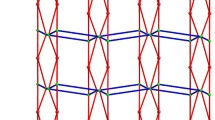Abstract
Treatment of Ni(OAc)2·4 H2O with 3,4-pyrazoledicarboxylic acid (H3pdc) and imidazole (ImH) in different metal-to-ligand ratios afforded two dinuclear nickel(II) complexes, [Ni(Hpdc)(ImH)(H2O)2]2·4 H2O (1) and [Ni(Hpdc)(ImH)2(H2O)]2·2.5 H2O (2), which were characterized by elemental analysis (EA), IR spectra and X-ray diffraction analysis and thermogravimetric analysis (TGA). Both in 1 and 2, the dinickle unit [Ni2(µ2-Hdpc)2] with six-numbered Ni2N4 ring was formed by a pair of µ2-Hpdc2− ligands linked two Ni(II) ions in N,O-chelating and N‒N-bridging fashions. The dinuclear units in 1 and 2 were expanded to 2D layer structures though hydrogen-bonding interactions between coordination water molecules, ImH molecules and carboxylate oxygen atoms, whereas the lattice water molecules in 1 and 2 just embedded in the 2D layer through intermolecular hydrogen bonding interactions. Finally, the 2D sheets in 1 were further assembled to a 3D supramolecular architecture via intermolecular C–H⋯O hydrogen bond. Besides, the luminescent and electrochemical properties of two complexes have been reported.
Graphic Abstract
Two dinuclear nickel(II) complexes, [Ni(Hpdc)(ImH)(H2O)2]2·4 H2O (1) and [Ni(Hpdc)(ImH)2(H2O)]2·2.5 H2O (2), were obtained by assembling of a Ni(II) ion, 3,4-pyrazoledicarboxylic acid (H3pdc) and imidazole (ImH) in different metal-to-ligand ratios. In 1 and 2, the O(C, N)−H⋯O hydrogen bonds expanded the dinuclear complexes to 3D/2D supramolecular structures, respectively.









Similar content being viewed by others
References
Heine J, Müller-Buschbaum K (2013) Chem Soc Rev 42:9232
Cui YJ, Yue YF, Qian GD, Chen BL (2012) Chem Rev 112:1126
Wang B, Lv XL, Feng DW, Xie LH, Zhang J, Li M, Xie YB, Li JR, Zhou HC (2016) J Am Chem Soc 138:6204
Liu J, Thallapally PK, McGrail BP, Brown DR, Liu J (2012) Chem Soc Rev 41:2308
Li J, Chen S, Jiang LY, Wu DP, Li YS (2019) Inorg Chem 58:5410
Li JR, Sculley JL, Zhou HC (2012) Chem Rev 112:869
Li JR, Yu JM, Lu WG, Sun LB, Sculley J, Balbuena PB, Zhou HC (2013) Nature Commun 4:1538
Raya-Baron A, Oyarzabal I, Arrabal-Campos FM, Seco JM (2017) Inorg Chem 56:8768
Bar AK, Pichon C, Sutter JP (2016) Coord Chem Rev 308:346
Lee JY, Farha OK, Roberts J, Scheidt KA, Nguyen ST, Hupp JT (2009) Chem Soc Rev 38:1450
Yoon M, Srirambalaji R, Kim K (2012) Chem Rev 112:1196
Lv XL, Wang KC, Wang B, Su J, Zou XD, Xie YB, Li JR, Zhou HC (2017) J Am Chem Soc 139:211
Miao LL, Li HX, Yu M, Zhao W, Gong WJ, Gao J, Ren ZG, Wang HF, Lang JP (2012) Dalton Trans 41:3424
Citrak SC, Bdeir K, Delgado-Cunningham K, Popple D, Oliver SRJ (2019) Inorg Chem 58:7189
Li GP, Zhang K, Zhang PF, Liu WN, Tong WQ, Hou L, Wang YY (2019) Inorg Chem 58:3409
Liu D, Lang FF, Zhou X, Ren ZG, Young DJ, Lang JP (2017) Inorg Chem 56:12542
Zhang SW, Shi W, Cheng P (2017) Coord Chem Rev 352:108
Ockwig NW, Delgado-Friedrichs O, O’Keeffe M, Yaghi OM (2005) Acc Chem Res 38:176
Wimberg J, Scheele UJ, Dechert S, Meyer F (2011) Eur J Inorg Chem 22:3340
Wu CJ, Lin CY, Cheng PC, Yeh CW, Chen JD, Wang JC (2011) Polyhedron 30:2260
Stadler AM, Kyritsakas N, Vaughan G, Lehn JM (2007) Chem Eur J 13:59
Hutchinson DJ, Cameron SA, Hanton LR, Moratti SC (2012) Inorg Chem 51:5070
Bu XH, Chen W, Hou WF, Du M, Zhang RH, Brisse F (2002) Inorg Chem 41:3477
Chakraborty B, Halder P, Paine TK (2011) Dalton Trans 40:3647
Amoore JJM, Black CA, Hanton LR, Spicer MD (2005) Cryst Growth Des 5:1255
Blake AJ, Champness NR, Hubberstey P, Li WS, Withersky MA, Schroder M (1999) Coord Chem Rev 183:117
Zhao FH, Jing S, Che YX, Zheng JM (2012) CrystEngComm 14:4478
Liu J, Cheng ML, Yu LL, Chen SC, Shao YL, Liu Q, Zhai CW, Yin FX (2016) RSC Adv 6:52040
Tang LZP, Yang MW, Cheng ML, Liu Q (2015) Chin J Inorg Chem 31:603
Cheng ML, Tao F, Chen LT, Wang LD, Liu Q (2015) Inorg Chim Acta 429:22
Chen LT, Tao F, Wang LD, Hong J, Jia XY, Bao JT, Ji YZ, Cheng ML, Liu Q (2013) Z Anorg Allg Chem 639:552
Tao F, Chen LT, Cheng ML, Liu Q (2014) Chin J Inorg Chem 30:2105
Cheng ML, Sun L, Han W, Wang S, Liu Q, Sun XQ, Xi HT (2016) New J Chem 40:10504
Cheng ML, Bao JT, Wu YJ, Yang BX, Wang QH, Sun L, Liu Q (2018) ChemistrySelect 3:4811
Jones RG (1951) J Am Chem Soc 73:3684
Sheldrick GM (2008) Acta Crystallogr A64:112
Mahata P, Natarajan S (2005) Eur J Inorg Chem 11:2156
Zhang SY, Li YH, Li W (2009) Inorg Chim Acta 362:2247
Li SL, Lan YQ, Ma JF, Yang J, Wei GH, Zhang LP, Su ZM (2008) Cryst Growth Des 8:675
Wang LD, Tao F, Cheng ML, Liu Q, Han W, Wu YJ, Yang DD, Wang LJ (2012) Chin J Inorg Chem 65:923
Acknowledgements
The project was supported by the National Natural Science Foundation of China (No. 21101018), Priority Academic Program Development of Jiangsu Higher Education Institutions (No. 13KJB150001), and the Natural Science Foundation of State Key Laboratory of Coordination Chemistry of Nanjing University.
Author information
Authors and Affiliations
Corresponding authors
Additional information
Publisher's Note
Springer Nature remains neutral with regard to jurisdictional claims in published maps and institutional affiliations.
Rights and permissions
About this article
Cite this article
Cheng, ML., Liu, L., Sun, L. et al. Metal-to-Ligand Ratio Controlled Assembly of Two Ni(II) Complexes: Structures, Luminescent and Electrochemical Properties. J Chem Crystallogr 51, 265–272 (2021). https://doi.org/10.1007/s10870-020-00854-1
Received:
Accepted:
Published:
Issue Date:
DOI: https://doi.org/10.1007/s10870-020-00854-1




